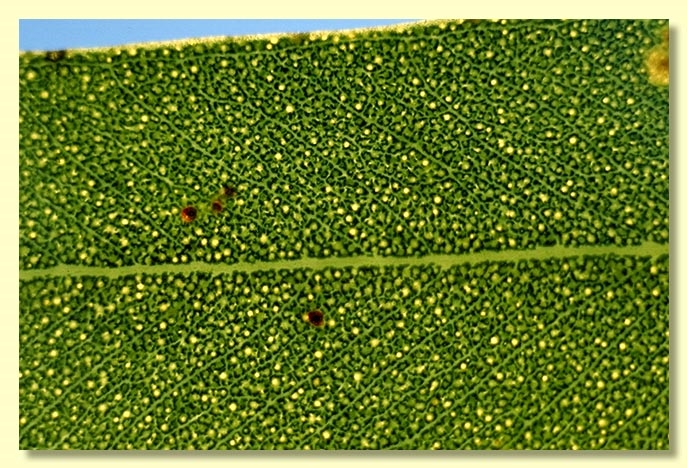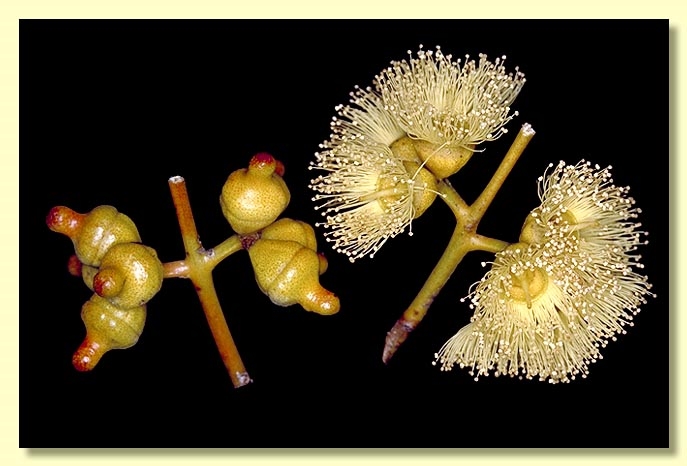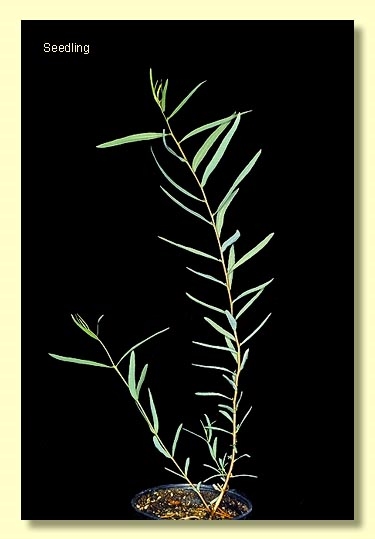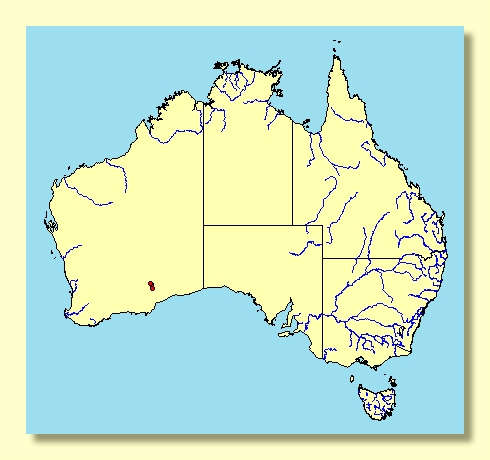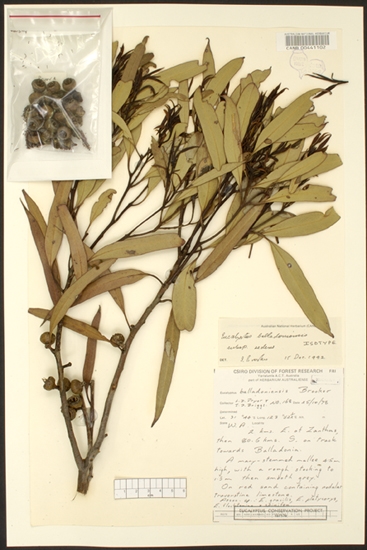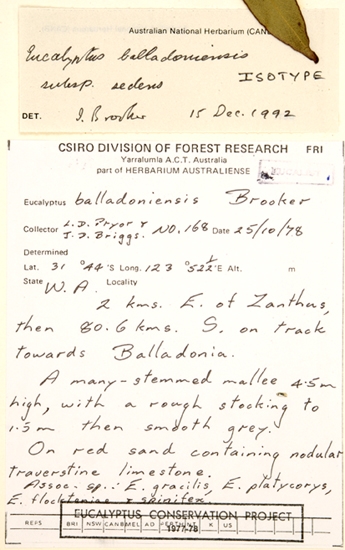Euclid - Online edition
Eucalyptus balladoniensis subsp. sedens
Eucalyptus | Symphyomyrtus | Bisectae | Destitutae | Balladonienses
Bark rough, firm (compacted), fibrous to flaky on lower half of stems, dark grey, then shedding in short ribbons above to show smooth grey-brown to pink-brown and cream bark.
Branchlets lacking oil glands in the pith.
Juvenile growth (coppice or field seedlings to 50 cm): stems rounded in cross-section; juvenile leaves sessile to shortly petiolate, alternate, linear to narrowly lanceolate, 10–15 cm long, 0.6–2 cm wide, dull, grey-green.
Adult leaves alternate, petioles 1.2–2.5 cm long; blade lanceolate, 7–13.5 cm long, 1–2.2 cm wide, base tapering to petiole, margin entire, apex acute, dull, bluish green at first maturing glossy, green, side-veins greater than 45° to midrib, reticulation dense, intramarginal vein close to margin, oil glands intersectional and island.
Inflorescences axillary unbranched, peduncles erect, 0.5–1 cm long, buds 7 per umbel, sessile or pedicels to 0.2 cm long only. Mature buds more or less truncate-globose but with a coarsely beaked operculum, 1.6–1.7 cm long, 1.1 cm wide, scar present, operculum with robust almost cylindrical beak, stamens inflexed, anthers globular to oblong, versatile, dorsifixed, dehiscing by short slits, style long and straight, stigma blunt, locules 3 to 5, the placentae each with 4 vertical rows of ovules. Flowers pale yellow.
Fruit sessile or rarely pedicels to 0.1 cm long, hemispherical to truncate-globose or obconical, 0.9–1 cm long, 1–1.4 cm wide, disc descending, valves 3 to 5, with exserted fragile style remnants
Seeds grey-brown, 1.5–3 mm long, ovoid to flattened-ovoid, dorsal surface smooth, hilum ventral.
Cultivated seedlings (measured at ca node 10): cotyledons Y-shaped (bisected); stems rounded, square, or in some, apparently 5-sided in cross-section; leaves sessile to subsessile throughout, opposite for ca 5 nodes then becoming sub-opposite to alternate or spirally arranged, linear, 3–6 cm long, 0.3–0.8 cm wide, dull, grey-green.
Flowering has been recorded in July.
Eucalyptus balladoniensis is a mallee species endemic to Western Australia, distributed from the Balladonia area south-west towards Mt Ney and Mt Ridley. It grows in dry woodlands preferring sandy rises or calcareous sandy loams. It has rough bark and slightly glossy, green leaves. Bud clusters are spreading to pendulous. Buds are obese and the operculum is conspicuously contracted in the upper part to form a broad beak.
In the classification of Brooker (2000) E. balladoniensis belongs in Eucalyptus subgenus Symphyomyrtus section Bisectae subsection Destitutae because buds have two opercula, cotyledons are Y-shaped and branchlets lack oil glands in the pith. Within this subsection it is related closely to only one other species, E. indurata, the two species forming series Balladonienses. Both species have rough bark, flaky to fibrous and more or less compacted in E. balladoniensis and hard, compacted in E. indurata. Adult leaves are slightly glossy in E. balladoniensis and very glossy in E. indurata. E. balladoniensis has more bluntly and stoutly beaked opercula and larger buds and fruit. Both species have yellow flowers.
There are two subspecies:
E. balladoniensis subsp. balladoniensis
With distinctly pedicellate buds and fruit; with a wide distribution to the south of the Eyre Highway.
E. balladoniensis subsp. sedens
Has more or less sessile buds and fruit, pedicel if present very short; distributed only north of Balladonia towards Zanthus.
subsp. sedens: Latin sedens, sitting, referring to the sessile buds.



